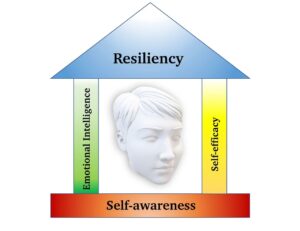Why measure your organization’s resiliency? (Part 1)


Higher resiliency creates culture change and success – Take the Quiz


Organizations routinely measure key performance indicators as part of ongoing and annual data reporting. Beyond typical departmental metrics, it is also within an organization’s best interest to measure and understand how resilient their workforce is.
Why should emotional intelligence be considered in the workplace
This deeper understanding of employee’s ability to bounce back from difficult and adverse situations allows the organization to strategically strengthen its workforce equipping them to be more prepared to successfully navigate ongoing growth and change.
Rapid and persistent change within an organization can be taxing to individuals, depleting their capacity to implement projects at an optimal organizational level. By assessing baseline resiliency and monitoring this on an ongoing basis helps the organization evaluate if its workforce can take on new challenges or upcoming projects in an efficient manner.
As the organization focuses on strengthening individual employee resiliency, there is a positive correlation and thus an effect on organizational emotional intelligence (EI). High EI organizations are in a better position to accomplish other ongoing business metrics by helping employees be more resilient and be able to function at their best.
Goleman's belief in measuring organizational EI
In measuring organizational EI, Goleman believes empathy and motivation are important in addition to self-awareness, self-management, social awareness, and relationship management. He says individuals must have the motivation to self-regulate and socially manage emotions as well as have the ability to empathize with those around them to accurately identify emotions.
Thus, organizations striving for higher EI must make these concepts part of their cultural values as well as model utilization. How successful the overall organizational EI is can be measured by exploring individual resiliency and EI. This is why organizations benefit from strengthening individuals that make up the whole.
There is a range of tools available: comprehensive ones like Yale’s MSCEIT and many shorter questionnaires that organizations can consider when measuring EI. As organizations improve their ability to identify, manage and regulate emotions these skills can be utilized to more accurately read people for feedback, better communicate a vision and lead people, aid in group problem solving, and to integrate emotions and make more accurate decisions.
The importance of emotional intelligence at workplace
We have discussed reasons why EI should be considered within employees but to further illustrate its importance, it is helpful to gain a glimpse into what poor EI looks like. Leaders with low EQ may display attitudes and behaviors such as:
- Criticizing other people when they make mistakes
- Refusing to accept personal responsibility for errors
- Always playing the role of the victim
- Refusing to accept critical feedback
- Using passive, aggressive, or passive-aggressive styles of communication
- Refusing to integrate with the team
- Not being open to others’ opinions
Consider the impact on employees, departments, and an organization’s ability to meet goals when leaders have these attitudes and behaviors. If organizations support leaders maintaining these characteristics, it will interfere with their ability to work efficiently. If we extrapolate this finding to all employees instead of solely leadership, the negative impact on the workplace becomes compounded.
Furthermore, EI is directly correlated to higher levels of job satisfaction, which positively impacts employee retention. These are just a few reasons, within the growing body of evidence, of why measuring organizational EQ is important. As organizations invest in strengthening their culture, efforts promoting positive behavior impact employee’s performance.
Psychological capital, which includes hope, efficacy, resiliency, and optimism also have an impact on employee performance. There are multiple considerations, factors and paths to improve resiliency and thus EI. In examining these it is also important to understand what gets in the way of building it
As we explore barriers to resiliency, Forbes found that hierarchy, unclear work processes, insufficient support and task overload as contributing factors to reduced resiliency. It is important to spend time addressing these areas to reduce turnover, improve productivity, improve teamwork, and clarity on what items need to be focused on which all positively impacts resiliency.
Improvements in these areas will fill the employee’s tank and help them adapt and recover more quickly which better positions the organization for competitive action. The Woodsite Institute sites four steps to incorporate resiliency:
- Cross-functional decision making
- Invest in experimental innovative strategies
- Careful examination of resource allocation that includes opportunities for new ventures
- Effective corporate governance
To the organization, Ajivar provides a dashboard of where its employees are as an aggregate with regards to EI/Resiliency. The organization can have a real-time metric of the mental wellness of its workforce. As the organization implements strategies designed to positively impact internal programs, their effect at improving wellness can be measured immediately.
Ajivar gives organizations a practical tool to gauge its intended success allowing for continued progress thus the ability to pivot and change tactics to more accurately impact positive change. Learn more about Ajivar here
We have developed a short survey to measure your organization’s EI with the focus on the individual employee’s resiliency. This tool combines existing research with your real-time collective feedback; thus, it is meant to evolve quickly. Your responses will help develop ongoing versions. Click here to test your organizational resiliency using our brief Organizational Resiliency Quiz
Post navigation
Related Posts


The Power of Mindfulness
Emerging research has shown incredible benefits of practicing mindfulness on a daily basis, particularly meditation.


What are Posimations?
Posimations, a cool term we invented at Ajivar, are really an abbreviation of “positive affirmations.”


We change the world by increasing Emotional Intelligence
~ Self-awareness is key ~Emotional intelligence (EI), is a competency skill that covers many areas


Accepting your mind chatter
You are fully in charge! If experts say that we have about 70,000 thoughts in